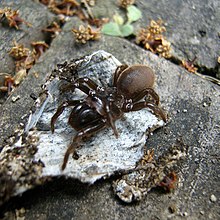| Atypus Temporal range: Palaeogene–present PreꞒ Ꞓ O S D C P T J K Pg N | |
|---|---|

| |
| A. karschi | |
| Scientific classification | |
| Domain: | Eukaryota |
| Kingdom: | Animalia |
| Phylum: | Arthropoda |
| Subphylum: | Chelicerata |
| Class: | Arachnida |
| Order: | Araneae |
| Infraorder: | Mygalomorphae |
| Family: | Atypidae |
| Genus: | Atypus Latreille, 1804 |
| Type species | |
| A. piceus (Sulzer, 1776) | |
| Species | |
|
33, see text | |
| Synonyms | |
| |
Atypus, also called purseweb spiders, is a genus of atypical tarantulas first described by Pierre André Latreille in 1804. It occurs in Eurasia, with one species (A. affinis) reaching into North Africa. Only three of the described species occur in Europe: A. piceus, A. affinis, and A. muralis. Specimens from the USA formerly known as A. snetsingeri represent an introduced population of A. karschi.
Peasants in the southern Carpathian Mountains used to cut up tubes built by Atypus and cover wounds with the inner lining. It reportedly facilitated healing and even connected with the skin. This is believed to be due to antiseptic properties of spider silk (which is made of protein). Atypus cobwebs have also been used in Sichuan and Tibet to manage the symptoms of diabetes.
Identification features
They are three-clawed, medium to large spiders with eight eyes. They have six spinnerets with the median spinneret truncated. The prolateral sides of the maxillae are elongated. The cephalic side of the cephalothorax is elevated. They have large chelicerae with long and thin fangs. The male sternum has marginal ridges.
Species
As of November 2022 it contains 33 species:
- Atypus affinis Eichwald, 1830 – Europe (Britain to Ukraine), North Africa
- Atypus baotianmanensis Hu, 1994 – China
- Atypus baotingensis Li, Xu, Zhang, Liu, Zhang & Li, 2018 – China (Hainan)
- Atypus coreanus Kim, 1985 – Korea
- Atypus dorsualis Thorell, 1897 – Myanmar, Thailand
- Atypus flexus Zhu, Zhang, Song & Qu, 2006 – China
- Atypus formosensis Kayashima, 1943 – Taiwan
- Atypus heterothecus Zhang, 1985 – China
- Atypus javanus Thorell, 1890 – Indonesia (Java)
- Atypus jianfengensis Li, Xu, Zhang, Liu, Zhang & Li, 2018 – China (Hainan)
- Atypus karschi Dönitz, 1887 – China, Taiwan, Japan
- Atypus lannaianus Schwendinger, 1989 – Thailand
- Atypus largosaccatus Zhu, Zhang, Song & Qu, 2006 – China
- Atypus ledongensis Zhu, Zhang, Song & Qu, 2006 – China
- Atypus magnus Namkung, 1986 – Russia (Far East), Korea
- Atypus medius Oliger, 1999 – Russia (Far East)
- Atypus minutus Lee, Lee, Yoo & Kim, 2015 – Korea
- Atypus muralis Bertkau, 1890 – Central Europe to Iran and Turkmenistan
- Atypus pedicellatus Zhu, Zhang, Song & Qu, 2006 – China
- Atypus piceus (Sulzer, 1776) (type) – Europe (France to Russia), Iran
- Atypus quelpartensis Namkung, 2002 – Korea
- Atypus sacculatus Zhu, Zhang, Song & Qu, 2006 – China
- Atypus seogwipoensis Kim, Ye & Noh, 2015 – Korea
- Atypus sinensis Schenkel, 1953 – China
- Atypus sternosulcus Kim, Kim, Jung & Lee, 2006 – Korea
- Atypus suiningensis Zhang, 1985 – China
- Atypus suthepicus Schwendinger, 1989 – Thailand
- Atypus sutherlandi Chennappaiya, 1935 – India
- Atypus suwonensis Kim, Kim, Jung & Lee, 2006 – Korea
- Atypus tibetensis Zhu, Zhang, Song & Qu, 2006 – China
- Atypus wataribabaorum Tanikawa, 2006 – Japan
- Atypus wii Siliwal, Kumar & Raven, 2014 – India
- Atypus yajuni Zhu, Zhang, Song & Qu, 2006 – China
Medical usage
The cobwebs produced by spiders in the genus Atypus, called Huidouba, have traditionally been consumed in Sichuan and Tibet to manage the symptoms of diabetes. Several studies have corroborated their therapeutic effects.
Peasants in the southern Carpathian Mountains used to cut up tubes built by Atypus and cover wounds with the inner lining. It reportedly facilitated healing and even connected with the skin. This is believed to be due to antiseptic properties of spider silk (which is made of protein).
References
- ^ "Gen. Atypus Latreille, 1804". World Spider Catalog Version 20.0. Natural History Museum Bern. 2019. doi:10.24436/2. Retrieved 2019-05-16.
- Kraus, O.; Baur, H. (1974). "Die Atypidae der West-Paläarktis: Systematik, Verbreitung und Biologie (Arach. : Araneae)". Abhandlungen und Verhandlungen des Naturwissenschaftlichen Vereins in Hamburg. Neue Folge. 17: 88.
- Latreille, P. A. (1804). "Tableau methodique des Insectes". Nouveau Dictionnaire d'Histoire Naturelle, Paris. 24: 129–295.
- Řezáč, Milan; Tessler, Steven; Heneberg, Petr; Herrera, Ivalú Macarena Ávila; Gloríková, Nela; Forman, Martin; Řezáčová, Veronika; Král, Jiří (2022). "Atypus karschi Dönitz, 1887 (Araneae: Atypidae): An Asian purse-web spider established in Pennsylvania, USA". PLOS ONE. 17 (7): e0261695. Bibcode:2022PLoSO..1761695R. doi:10.1371/journal.pone.0261695. PMC 9262232. PMID 35797267.
- ^ Heimer, Stefan (1988). Wunderbare Welt der Spinnen (in German). Urania. p. 14. ISBN 3332002104.
- ^ Yan, Li-Shan; Cheng, Brian Chi-Yan; Zhang, Shuo-Feng; Luo, Gan; Zhang, Chao; Wang, Qing-Gao; Fu, Xiu-Qiong; Wang, Yi-Wei; Zhang, Yi (2021-10-21). "Tibetan Medicine for Diabetes Mellitus: Overview of Pharmacological Perspectives". Frontiers in Pharmacology. 12: 748500. doi:10.3389/fphar.2021.748500. ISSN 1663-9812. PMC 8566911. PMID 34744728.
- Sebastin, P.A.; Peter, K.V., eds. (2009). Spiders of India. Universities Press. ISBN 978-81-7371-641-6.